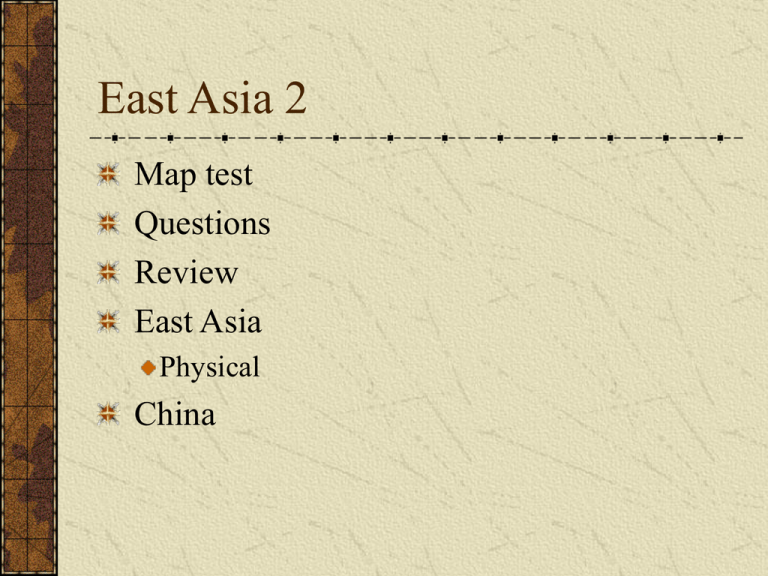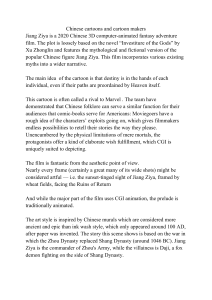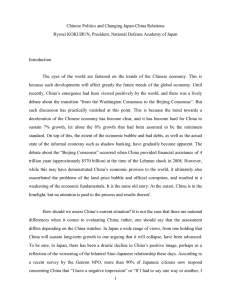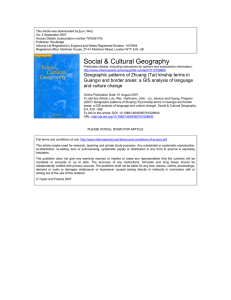East Asia 2 Map test Questions Review
advertisement

East Asia 2 Map test Questions Review East Asia Physical China Regions of the Realm - Review China proper- eastern half; the core Xizang (Tibet)- high elevation; sparsely populated Xinjiang- vast desert basin & mountain rim Mongolia- a desert, buffer state Jakota triangle Japan, South Korea, Taiwan Rapid economic development E A S T A S I A Physiography and Climate of Chna Longitudinal extent is comparable to Canada 75° Latitudinal range from Northern Quebec to central Caribbean Bordered by Pacific and 4 seas, Mountains: e.g. Kunlun Shan, Himalayas Steppe and desert Monsoon Asia Climate Comparison Chinese Perspectives Culture hearth-Huang He – Yellow River Civilization for over 4,000 years China as center of the civilized world Natural protection and isolation distance ocean and mountain barriers COLONIAL SPHERES Opium Wars 1842, 1857 Imperial pressures Britain France Portugal Germany Russia Japan Extraterritoriality Doctrine of European international law ‘diplomatic immunity’ Nineteenth century treaty ports, enclaves e.g. Qingdao Erosion of Chinese sovereignty Shanghai American, British, French Concessions Canton China’s Political Map 4 central-government-administered municipalities Beijing (capital); Tianjin (Bo Hai Gulf); Shanghai (Chang Jiang); Chongqing (upper Chang Jiang) 5 autonomous regions Nei Mongol (Inner Mongolia); Ningxia Hui; Xinjiang; Guangxi Zhuang (South); Xizang (Tibet) 22 provinces Grow in size from east to west 2 Special Administrative Regions Xianggang (1997 - Hong Kong) Macau (1999 – Portugese Macao ETHNIC GROUPS Han Chinese Zhuang Uygur Hiu Yi Tibetan Miao Manchu Mongol Buyi Korean 91.9% 8.1% Communist Revolution 1949 Communists prevail Soviet style expropriation and collectivization of agriculture State-owned enterprise, heavy industry Great Leap Forward 1958-1960 Economic restructuring: 24,000 rural communes, brigades, work teams – division of labour 600,000 back yard, charcoal-based steel industry produced 11 million tonnes of steel Party cadres apply doctrine and red book Great Leap Forward 1958-1960 Rapid and sweeping socio-economic transformation & propaganda Steel broke, farm machinery fell apart, backyard furnaces also used too much coal, China’s railways could not move resources Too much labour was moved out of agriculture to increase industrial output Floods, drought, famine, starvation, disease 20-30 million died Great Leap Forward 1958-1960 Mao concedes defeat: “The chaos caused was on a grand scale, and I take responsibility. Comrades, you must all analyse your own responsibility. If you have to fart, fart. You will feel much better for it.” Private ownership and production was reinstated Communes were reduced in size Great Proletarian Cultural Revolution 1965-1968 Purge of all educated professionals Red Guards – youthful gangs oppose elites Permanent revolution closing schools to eliminate bourgeois ideas Labour camps for "re-education“ Millions executed/ or "commited suicide" Ends with Mao's death in 1976 Deng Xiaoping Era Liberalized Communist dogma with capitalist economic practices, “socialist market economy” Open door policy Access to foreign science and technology Permitted students to study abroad Decentralized decision-making Restructured agriculture Created SEZs, Open Cities, Open Coastal Areas Growth poles Containment of foreign influence Languages World’s oldest active language, Sino-Tibetan Family. Spoken dialects not mutually intelligible but characters are the same. Kanji – Japanese for Chinese character Transliteration - Romanji PINYIN SYSTEM Language as centripetal force Adopted in 1958 from northern Mandarin Standard form of Chinese Peking→Beijing Canton→Guangzhou Chunking→Chongquing Sinkiang→Xinjiang Yangtse (regional)→Chang Jiang PINYIN System for Romanizing & transliterating Chinese Chinese Translation Bei Nan Xi Dong Jing Shan He Jiang south) North South West East Capital Mountain River (in the north) River (in the China’s Population 1.306 billion Annual rate of natural increase 0.7% (1970s - 3%) Doubling time: 100 years Life expectancy: 70 (males), 73 (females) TFR 1.8 (1997) Arithmetic density: 353 people/sq mi Physiological density: 3,524 people/sq mi Only 10% of the land is arable and 69% of the population lives on this land POPULATION DENSITY






